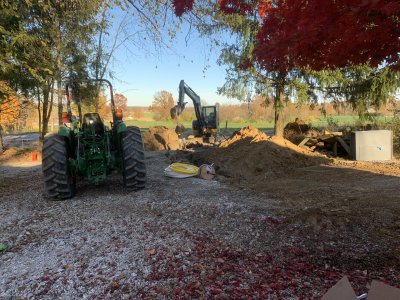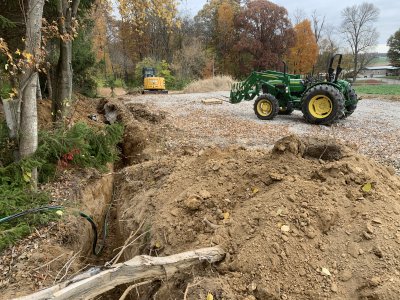-
Welcome back Guest! Did you know you can mentor other members here at H-M? If not, please check out our Relaunch of Hobby Machinist Mentoring Program!
You are using an out of date browser. It may not display this or other websites correctly.
You should upgrade or use an alternative browser.
You should upgrade or use an alternative browser.
New shop! (was: Multiple buildings, ...)
- Thread starter rabler
- Start date
- Joined
- Feb 25, 2021
- Messages
- 3,271
- Joined
- Feb 25, 2021
- Messages
- 3,271
I do enjoy running the excavator. The electronic controls on the newer ones make it a lot less fatiguing to operate the joysticks, and make it easy to maintain fine control. The thumb on the excavator is convenient for picking up stumps, limbs, etc. Here is a view from the corner of the house. The driveway is just about impassible right now. I've got a couple red cones across the driveway to avoid someone driving up and hitting the trench or the spools of various lines going in. UPS trucks worry me 

Got the digging done up to the two foot buffer for the power line. Need to fire up the pressure washer today and expose the buried line. It was a bit chilly last night (25F), so waiting for it to warm up before working with water.

Got the digging done up to the two foot buffer for the power line. Need to fire up the pressure washer today and expose the buried line. It was a bit chilly last night (25F), so waiting for it to warm up before working with water.
- Joined
- Feb 25, 2021
- Messages
- 3,271
The buried power main from the pole to the meter, should be buried about 3' down. I had the 811 service come out and mark the location. By law in Indiana (most states) you can not use power equipment to dig closer than 2' of the marked location, technically 2' + the radius of the service, so if you're dealing with a 2' sewer main, it would be 3'. Within that 2' you need to expose the underground utility by hand before continuing with any heavy equipment. Since my utilities to the new building need to cross the power main, it needs to be dug up by hand. Some google searching reveals that using a pressure washer is a reasonable way to dig "by hand" as long as you keep the wand at least 8" (I'm going with 12") from any potential utility.Randal,
Please explain the " two foot buffer for the power line". I don't know why, where, what the intention is.
- Joined
- Nov 24, 2014
- Messages
- 3,597
Looking at your Utility Layout Sketch, I'm wondering if you are trying to put the new conductors in the same trench as the existing service conductors (lots of power washing)? Or, are the new conductors going in a new, essentially parallel trench, so the pressure washing will only be in close proximity to the existing meter/disconnect panel?
- Joined
- Feb 25, 2021
- Messages
- 3,271
Looking at your Utility Layout Sketch, I'm wondering if you are trying to put the new conductors in the same trench as the existing service conductors (lots of power washing)? Or, are the new conductors going in a new, essentially parallel trench, so the pressure washing will only be in close proximity to the existing meter/disconnect panel?
Parallel trench greater than 2' appart for the power lines, so only place of proximity is the existing disconnect. Soil here is clay, so any length of pressure washer digging would truly be tedious (and cold). But the fiber optic, gas, and water lines are coming from the house so they need to cross the existing service entrance for the power.
Ideally the gas, water and fiber would be in separate trenches in case there is cause to dig one up at a later time. But given they have to cross that buried power cable, they are all going in together. Safe bury depth for water here is about 32" for frost purposes. I'm trenching most of it 4' down, but may cross above the power line which should be at 36" or more deep. If I come above 3' with the water/gas/fiber, I'll put them in a conduit bundle with a bit EPS foam over them and then pour some concrete over that.
Last edited:
I like your crossover plan. I’d be tempted to lay an open pipe somewhere along the way in case of future needs.
I hear what you are saying about the excavator. A modern one sounds nice. I’ve played with my dad’s small track loader/excavator in Hawaii. Back during initial construction I dropped my end of a granite countertop and broke the corner off, so I can appreciate the beauty of electronic controls.
I hear what you are saying about the excavator. A modern one sounds nice. I’ve played with my dad’s small track loader/excavator in Hawaii. Back during initial construction I dropped my end of a granite countertop and broke the corner off, so I can appreciate the beauty of electronic controls.
- Joined
- Feb 25, 2021
- Messages
- 3,271
That's not a bad idea, a couple of capped 3" or 4" conduits, 5' long, perpendicular to the new stuff, with a locator tape tied to each end up to the surface.I like your crossover plan. I’d be tempted to lay an open pipe somewhere along the way in case of future needs.
I hear what you are saying about the excavator. A modern one sounds nice. I’ve played with my dad’s small track loader/excavator in Hawaii. Back during initial construction I dropped my end of a granite countertop and broke the corner off, so I can appreciate the beauty of electronic controls.
Of course, it may make the most sense to stub something like that in through the floor of the new building.
Last edited:
- Joined
- Nov 25, 2015
- Messages
- 9,742
is capping with concrete normal?
do they require a tracer wire ? Around here certain lines require a tracer line that they can hook up a transmitter to and use a receiver to trace it out. I'm just not sure which type of service lines require it.
do they require a tracer wire ? Around here certain lines require a tracer line that they can hook up a transmitter to and use a receiver to trace it out. I'm just not sure which type of service lines require it.


